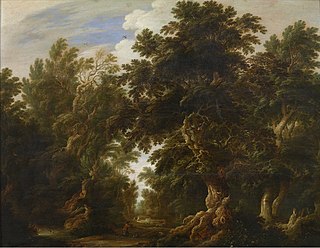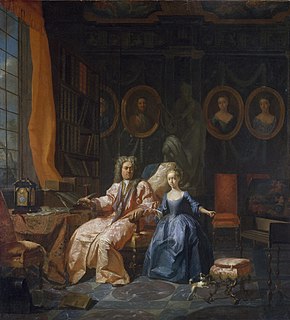
Chrispijn van den Broeck was a Flemish painter, draughtsman, print designer and designer of temporary decorations. He was a scion of a family of artists, which had its origins in Mechelen and later moved to Antwerp. He is known for his religious compositions and portraits as well as his extensive output of designs for prints. He was active in Antwerp which he left for some time because of the prosecution of persons adhering to his religious convictions.

Gonzales Coques was a Flemish painter of portraits and history paintings. Because of his artistic proximity to and emulation with Anthony van Dyck he received the nickname de kleine van Dyck. Coques also worked as an art dealer.

Clara Peeters was a Flemish still-life painter from Antwerp who worked in both the Spanish Netherlands and Dutch Republic.

The Guild of Saint Luke was the most common name for a city guild for painters and other artists in early modern Europe, especially in the Low Countries. They were named in honor of the Evangelist Luke, the patron saint of artists, who was identified by John of Damascus as having painted the Virgin's portrait.

Theodoor Rombouts was a Flemish painter who is mainly known for his Caravaggesque genre scenes depicting lively dramatic gatherings as well as religiously-themed works. He is considered to be the primary and most original representative of Flemish Caravaggism. These Caravaggisti were part of an international movement of European artists who interpreted the work of Caravaggio and the followers of Caravaggio in a personal manner.

Alexander Keirincx was a Flemish landscape painter who is known for his wooded landscapes with figures as well as his 'portraits' of English castles and country houses. After training in his native Antwerp, he worked in Utrecht and ultimately to Amsterdam in the Dutch Republic. During a period of sojourn in England in the late 1630s he worked on commissions for the English king. He was a regular collaborator of Cornelis van Poelenburch.

Jan Wellens de Cock was a Flemish painter and draftsman of the Northern Renaissance.

Cornelis Galle the Younger, Cornelius Galle or Cornelis Galle (I) was a Flemish printmaker. He worked mainly on publications for the Plantin Press in Antwerp for which he engraved devotional prints and book illustrations.

Gaspar or Casper van Eyck was a Flemish painter of marine subjects and sea-fights. He worked in Antwerp and spent some time working in Genoa and Madrid.

Jan Pauwel Gillemans the Younger was a Flemish still life painter. He worked in a range of still life genres including flower and fruit still lifes, banquet still lifes, pronkstillevens and hunting pieces. He collaborated with figure painters to create landscapes which combined a mythological or allegorical scene with a still life. He worked and lived in Antwerp, Middelburg, London and Amsterdam.

Gaspar Peeter Verbruggen or Gasparo Pedro Verbruggen was a Flemish still life painter who is principally known for his decorative still lifes with flowers and fruit. He collaborated with figure artists on compositions which combined figures with a still life element. He was active in Antwerp and The Hague.

Pieter Verbrugghen the Youngeror Pieter Verbrugghen II(1648, Antwerp - after 1691, Antwerp) was a Flemish sculptor, draughtsman, etcher and stone merchant.

Jacques de l'Ange or the Monogrammist JAD was a Flemish painter and draughtsman known for his genre scenes and history paintings executed in a Caravaggesque style. The artist was only rediscovered in the mid-1990s as his work was previously attributed to other Northern Caravaggists and in particular those of the Utrecht School.

Jan Carel Vierpeyl or Jan Carel Vierpyl was a Flemish painter known mainly for his family portraits and genre scenes of merry and gallant companies.

Cornelis van Huynen was a Flemish still life painter who is known for his fruit and garland paintings. He was active in Antwerp where he had trained with the prominent still life painter Joris van Son.

Lodewijk van Schoor was a Flemish painter, draughtsman and designer of tapestries. Van Schoor was one of the major figures of Flemish tapestry design in the late 17th and early 18th century, together with Victor Honoré Janssens and Jan van Orley.

Bartholomeus de Momper (I) or Bartholomeus de Momper the Elder was a Flemish publisher, printer, draughtsman and art dealer. He was a member of de Momper family, a prominent family of landscape painters and printmakers, originally from Bruges, which had settled in Antwerp in the 16th century.

Jacob Herreyns or Jacob Herreyns (I) Antwerp, baptized on 23 December 1643 – Antwerp, 1 January 1732) was a Flemish painter, printmaker and designer of tapestries. He worked in Antwerp where he painted many altarpieces. He was a known staffage painter who added the figures in the landscapes of other artists. As a printmaker, he produced mostly prints of mythological subjects. He held also the position of 'muntmeester' of Brabant.

Pieter van der Hulst the Younger or Pieter van der Hulst (II) was a Flemish landscape and genre painter who was active in Antwerp. He was an assistant of Rubens for some time.

Maria Tassaert was a Flemish still life painter active in Antwerp. She had a short career during which she painted garland paintings, a type of still life painting comprising a garland of flowers around a devotional or other image. She was a member of the Tassaert family of artists, which was active in the Habsburg Netherlands, France, Prussia and England in the 17th and 18th centuries.




















